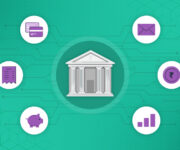Open banking is a significant development that enables secure data sharing and collaboration between financial institutions, technology companies, and customers. It breaks down traditional barriers in finance by facilitating secure collaboration and data sharing between all stakeholders. As a result, this empowers customers, fuels competition, and drives innovation in financial services.
As per estimates, the value of open banking transactions worldwide will grow by more than 500 % between 2023 and 2027. It is expected to rise from 57 billion U.S. dollars to 330 billion U.S. dollars in this period.
Did you know, that experts suggest that it holds the potential to make the financial ecosystem more inclusive, safer and customer-centric? Let us discuss some future trends to understand open banking’s impact better.
Notable Open Banking Trends in 2025 You Must Know
Open banking is a financial services model that uses application programming interfaces (APIs) to let third-party developers access data in traditional banking systems. It gives consumers more control over their financial information while service providers can improve their decision-making and offer customised solutions. In a way, this model changes the way financial data is shared and accessed.
Let’s explore the emerging trends and future forecasts in open banking in 2025:
Tightening Data Security and Privacy Norms
Open banking and the increasing partnerships with technology partners can expose banks to more risks and cyberattacks. As generative artificial intelligence (AI) becomes more sophisticated, the threat of deep fakes is also growing, making it more challenging for financial institutions to discern human customers from those imitating their likenesses.
By 2025, governments will devise stricter regulatory frameworks and advanced security technologies to deal with these fast-evolving threats and protect consumer data. Innovations such as biometric authentication, blockchain, and AI-driven security protocols are some of the technological innovations that will help safeguard customer data and protect against breaches.
For example, U.K. government directives like PSD2 and the Open Banking Initiative are examples of regulators formulating guidelines to safeguard all stakeholders.
Synergy of Open Banking and AI and ML
Artificial intelligence and machine learning (ML) will continue to power the growth of open banking. Banks and fintech companies will be able to offer personalised services and proactive financial management advice leveraging these technologies.
AI-driven chatbots and virtual assistants will become more prevalent, providing instant support and tailored financial recommendations. Similarly, as voice-activated AI assistants become more sophisticated, integrating them with open banking platforms will redefine consumer interaction with their financial data.
Embedded Finance Will Become Mainstream
Embedded finance is when financial services like loans or payments are seamlessly integrated into non-financial apps like buying something right within a shopping app. Going forward, companies from various industries will offer banking services as part of their product offerings.
So, consumers can purchase insurance while booking a holiday package online or apply for a loan while shopping on an app. They can also enjoy a more convenient and integrated experience, blurring the lines between traditional financial institutions and other service providers.
Open banking acts as the springboard for embedded finance. It represents an innovation opportunity no longer restricted to only the financial sector and will lead to a more interconnected financial ecosystem.
Emphasis on Financial Inclusion
Open finance has the potential to reduce financial gaps and enhance financial inclusion.
CGAP study reveals data has the potential to be transformational for financial inclusion, and open finance can be the key to unlocking it.
Data-driven financial services can help close inclusion gaps. CGAP research further suggests that despite income and gender-based differences, more low-income people (including women) are generating digital data trails than ever before. The growth of data trails presents an enormous opportunity to focus more on financial inclusion.
By 2025, banks and FIs initiatives to extend banking services to unbanked and underbanked individuals will gain momentum. Data-driven financial services allow FIs to offer more varied and better-tailored financial solutions, including to previously unbanked or poorly banked customers.
Evolution of Open Finance
Open finance is the natural successor to open banking. Currently, it remains focused on sharing banking data; however, soon, this will expand to include a wider range of services, collectively known as open finance.
Open data use will evolve beyond traditional banking products to include mortgages, credit cards, insurance, foreign exchange, retirement products, and cryptocurrency. This expansion will facilitate innovation and provide consumers with better financial management tools and personalised services.
By 2025, FIs and banks will have a more holistic approach, enabling consumers to manage all their financial assets through a single platform.
For example, Australia and India are looking at how data exchange goes beyond the financial sector to facilitate a more open economy, where data is shared across industries, including telecommunications, energy, and agriculture.
Standardisation and Interoperability of APIs
The lack of standardised APIs is one of the major challenges open banking adoption faces. Currently, different banks and financial institutions use diverse API standards, making it difficult for third-party providers to adapt to each API.
Finezza’s entire suite of Loan Origination and Loan Management solutions is available via secure APIs and data pipelines for easy integration with your existing/legacy systems.
- Adopting common standards and protocols for APIs and ensuring applications from different providers can work together without extensive customisation can improve interoperability and reduce inconsistencies in data exchange.
- Standardisation can facilitate integration with multiple systems and enable seamless data exchange across platforms. The API should also be scalable and capable of handling a growing number of users and transactions without impacting performance.
The coming year will bring significant progress towards global standardisation, facilitating interoperability. This will enable a seamless experience for consumers and businesses.
To Sum It Up
Open banking is facilitating the creation of a more competitive and user-centric financial services landscape. The model is widely recognised and well-integrated into financial ecosystems and will continue to grow stronger in 2025 and beyond.
With financial institutions, fintechs, and regulators working together, consumers will benefit from improved choice, greater security, customised solutions and better financial wellbeing.
This banking model relies on the use of APIs that provide access to the bank’s core system and data. Efficient use of APIs helps businesses and consumers enjoy easy access to custom banking services without compromising safety.
Finezza’s suite of APIs and services makes creating safe, compliant and reliable open banking applications easy.
Get in touch with us today!




Leave a Reply